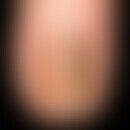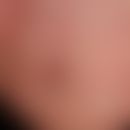Synonym(s)
DefinitionThis section has been translated automatically.
Nail diseases are basically defined by their appearance and the part of the nail affected: the nail plate, the tissues that support or hold the nail plate in place, or the lunula. Drugs trigger nail diseases by a variety of mechanisms. Some drugs affect the nail matrix epithelium, the nail bed or the paronychium. Others lead to changes in the colour of the nail. Other drugs induce photosensitivity of the nail matrix. Still others affect the blood supply to the nail unit. Most drug-induced nail diseases subside after discontinuation of the drug, although complete normalisation takes months or years.
Nail changes often occur after and during treatment with various drugs. cytostatic drugs. In a larger study, nail changes were detectable in 71.3% of the cytostatically treated patients (Zawar V et al. 2019). Taxanes, anthracyclines, fluorouracil, EGFR and tyrosine kinase inhibitors were the most frequent triggers of drug-induced nail dystrophies.
ClassificationThis section has been translated automatically.
/en/dermatology/nail-dyschromia-120409" title="Nail dyschromiaDrug-inducednail changes:
- Photoonycholysis: Mercaptopurine
- Onychomadesis: chemotherapeutic drugs e.g. docetaxel, antiepileptic drugs, antibiotics, lithium, gold preparations
- Brittle nails: cytostatics, retinoids
- Paronychia: retinoids, EGF receptor antagonists
- Unguis incarnatus: local mechanical irritation due to tight shoes and inadequate short cutting of the nail plate are decisive provocation factors. Drugs such as retinoids (e.g. acitretin) and antiretroviral preparations with retinoid-like side effects (indinavir, lamivudine) can trigger unguius incarnatus. Such changes are reversible after discontinuation of the preparations.
- Splinter haemorrhages: imatinib, doxycycline, pacliataxel, doxetaxel observed.
- Striated melanonychia: bleomycin, busulfan, cyclophosphamide, dacarbazine, docetaxel, fluorouracil, methotrexate; zidovudine
- Other nail dyschromas: tetracyclines and antimalarials (usually several or all nails are affected). Exogenous dyschromasias can be triggered e.g. by application of silver nitrate or potassium permanganate baths.
- Leuconychia: cisplatin, cytarabine, vincristine
- Beau-Reil transverse furrows: cycle-dependent damage causes repetitive Beau-Reil transverse furrows.
-
Mees transverse stripes: were originally described in cases of heavy metal poisoning (arsenic, thallium). They are an expression of damage to the nail matrix and occur, among other things, as a result of medication (cytostatic drugs).
LiteratureThis section has been translated automatically.
- Onder M et al(2001) Isotretinoin-induced nail fragility and onycholysis. J Dermatologist Treat12:115-116 Piraccini BM et al (1999) Drug-induced nail disorders: incidence, management and prognosis. Drug Saf 21:187-201.
- Piraccini BM et al (2007) Drug reactions affecting the nail unit: diagnosis and management. Dermatol Clin 25:215-221.
- Zawar V et al (2019) Nail changes due to chemotherapy: a prospective observational study of 129 patients. J Eur Acad Dermatol Venereol 33:1398-1404.
Outgoing links (10)
Beau-reilsche cross furrows of the nails; Leukonychie; Meese cross bands; Melanonychia; Nail dyschromia; Onycholysis drug-induced or light-induced; Onycholysis totalis; Paronychia (overview); Splinter hemorrhages; Unguis incarnatus;Disclaimer
Please ask your physician for a reliable diagnosis. This website is only meant as a reference.



